Companion@360 → 7 Month programme to sharpen your writing skills → REGISTER NOW

Border dispute India – Nepal
Nepal parliament passed the constitutional amendment bill giving approval of recent political map published by Nepal government including the territories of Limpiyadhura,Lipu Lekh and Kalapani.
These disputed territories were not originally included in the Nepal constitution promulgated in 2015 September
While India Nepal-India maintains open border and very cordial relations major border dispute between two exist in Kalapani and Susta.
- The Nepal kingdom of 19th century extended up to river Sutlej in the west to river Teesta in the east
- The two-year war between East India Company and Nepal in 1814 ( Anglo-Gorkha war) which led to the Sugauli treaty of 1816, demarcated the Kali river as the border of India and Nepal.
- While Kali river is the agreed boundary between two nation, there exists a difference of opinion over the origin of the Kali river.
- Nepal claims that Kali river starts at Limpiyadhura and the 370 sq km adjoining area belongs to Nepal.
- However, the area is occupied by India for long . Lipu Lekh is used for annual Kailash Manasasarovar pilgrimage and is an active trade route controlled by India.
- India has an active military outpost in these regions.
- Nepal claims that area was temporarily granted for Indian military for strategic purposes after 1961 indo China war by the king Mahindra of Nepal. Before 1962 Nepal government collected land revenue from this region and census were held.
- The dispute over the regions begins only in 1990s. In 2000 border negotiations were put in place under Vajpayee government but didn’t produce an outcome.
- The India China agreement in 2015 to develop Lipulekh as commercial and pilgrimage hub invited formal protest from Nepal and made claims over the region.
- The issue resurfaced in 2019 when New Delhi publishes new political map to reflect the changes following the decision on August 5 to reorganise the State of Jammu and Kashmir, and Nepal objected to the depiction of the disputed territory.
- The passage of the constitutional amendment and high decibel rhetoric leaves lesser space for diplomacy.
- India should shed its big brother attitude and should treat Nepal as an equal partner in all engagements.
- While Indian diplomacy needs to factor in ‘active Chinese presence ‘ as a third player, excess emphasis on China in Nepal-India equation could be counterproductive.
- Once celebrated the “special” relationship between the two countries can be rebuilt only through mutual trust.
Read Also India Nepal Relations
